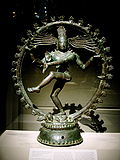You can help expand this article with text translated from the corresponding article in Tamil. (September 2021) Click [show] for important translation instructions.
|
This article needs additional citations for verification. (March 2014) |

In Hinduism, vibhuti (Sanskrit: विभूति, romanized: vibhūti), also called bhasmam or tirunīru, is sacred ash made of burnt dried wood, burnt cow dung and/or cremated bodies used in Agamic rituals.[1] Devotees of Shiva apply vibhuti traditionally as three horizontal lines across the forehead (also known as tripundra) and other parts of the body.[2]
According to the Shiva Purana, the particles of ash which cling to the skin when tripundra is applied are to be considered to be individual lingams. The scriptures further state that bhasma purifies the soul and elevates the devotee of Shiva, and that works done without wearing bhasma are fruitless. There are various methods for the application of the ashes, according to the Shiva Purana, and various mantras to be recited during application.[citation needed]
| Part of a series on |
| Shaivism |
|---|
 |
|
|
Other uses
[edit]Another meaning of vibhuti is a 'glorious form', in contrast with avatar, a reincarnation of Brahman.[3]
In the third chapter of the Yoga Sutras, which is called vibhuti-pada (chapter on mystical powers), the focus is on vibhutis (siddhis), which are understood as mystical powers attained through samyama, a concentrated application of the last three limbs of yoga (dharana, dhyana, and samadhi).[4]
Vaishnava theology describes a vibhuti as 'incarnation of power', a temporary occasional manifestation such as when holy men are infused with divine virtues and qualities are infused.[5]
Sri Aurobindo mentions a vibhuti as "the hero of a race's struggle towards divine achievement, the hero in the Carlylean sense of heroism, a power of God in man."[6]
Manufacture
[edit]Whether at home, at a festival or commercially, it is expected that suitable prayers or mantras or other ritual practices will take place at appropriate times.[7] Some people who produce vibhuti may prefer or insist that the various stages occur at certain times, such as the raw materials being collected on an auspicious day and the burning to occur during a festival celebration such as on Shivaratri.
While adulteration of vibhuti is frowned upon, fragrances in the form of herbs or other perfumes may be added either before burning in the form of herbs[8] or mixed into the powder after burning.[9]
Dung-based vibhuti
[edit]Fresh cow dung, preferably from varieties of cow seen historically in India and not European varieties like Jersey or Friesian,[7][10] is collected and formed into cakes, balls, or sheets. The size and shape depends upon how the dung will arranged for burning but a tennis ball size is common. Over a period of around a week the dung is dried in sunlight while resting on a cloth or stone that keeps it from coming into contact with the ground.[7]
The dried dung is then arranged in layers, alternating dung with a thin layer of paddy (rice hull that has not been processed to extract the grain, or even the whole plant except roots) or rice husks, and hay. This may occur in a fire pit or free standing such as a long triangular pile. The purpose of the plants is to provide heat while also preventing the dung itself from burning vigorously.[7] Vibhuti prepared in fire pits may be covered to restrict oxygen. Over a period of several days the fire results in the dung being reduced to a dark or, ideally, a pale grey or a white coloured ash. The balls of dung ash are then gathered and ground by hand or machine.
The ground ash may be washed in water with the slurry and collected in a filter cloth. The wet ash paste is dried by fire or sunlight; particularly if the ash is dark it is dried in fire to lighten it. This washed and dried vibhuti is then powdered again
Home production is similar to the process described above albeit on a smaller scale and the dung may be roasted in a metal vessel. During religious festivals the stack of materials may be ignited with fire from a homa.
Wood- or plant-based
[edit]Ashes made from various plants ascribed with spiritual or religious significance may be used. The plant itself is often burnt in a homa. Using certain types of plant may be indicated or contraindicated depending upon the user's astrological chart.[8]
See also
[edit]References
[edit]- ^ * Apte, Vaman Shivram. "A Practical Sanskrit Dictionary" p. 866.
- Making ash - the fire is lit on Sivaratri The Hindu, 2019-02-28.
- ^ Lochtefeld, James G. (2002). The Illustrated Encyclopedia of Hinduism: N-Z. Rosen. pp. 748–749. ISBN 978-0-8239-3180-4.
- ^ Kapoor, Subodh (1 January 2004). An Introduction to Epic Philosophy: Epic Period, History, Literature, Pantheon, Philosophy, Traditions, and Mythology. Cosmo Publications. p. 342. ISBN 9788177558807.
- ^ Bryant, Edwin F. (2009). The Yoga sūtras of Patañjali: a new edition, translation and commentary with insights from the traditional commentators. New York: North Point Press. pp. 301–302. ISBN 978-0-86547-736-0.
- ^ Dhavamony, Mariasusai (1 January 2002). Hindu-Christian Dialogue: Theological Soundings and Perspectives. Rodopi. p. 75. ISBN 9042015101.
- ^ Aurobindo, Sri (1 January 1992). Wisdom of the Gita: Second Series. Lotus Press. p. 21. ISBN 9780941524759.
- ^ a b c d "Making of Vibhuti - How is Vibhuti prepared?". shaivam.org. Retrieved 18 February 2025.
- ^ a b "Benefits of Bhasma/Vibhuti | Significance of Holy Sacred Ash". www.rudraksha-ratna.com. Retrieved 18 February 2025.
- ^ "PARAMAM PAVITRAM BABA VIBHUTIM - the Making of the Wondrous Holy Ash". archive.sssmediacentre.org. Retrieved 18 February 2025.
- ^ "Vibhuti / Bhasma / Thiruneeru – Meaning, Significance and it's Glorious Attributes | Sanskriti - Hinduism and Indian Culture Website". 4 March 2018. Retrieved 18 February 2025.
Further reading
[edit]- Dictionary of Hindu Lore and Legend (ISBN 0-500-51088-1) by Anna Dallapiccola
